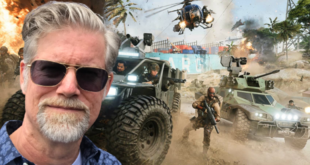Developer:
Dice
Publisher:
Electronic Arts
Audio Team:
Audio Director: Stefan Strandberg
Sound Design: Bence Pajor, Mari Saastamoinen, Ben Minto, Stefan Strandberg, Olof Strömqvist
Original Music: Mikael Karlsson
Dialogue Direction: Olof Strömqvist
Even down the line from Sweden, you can just tell Stefan Strandberg is oozing with an infectious enthusiasm and passion for audio in games.
He says it like it is, his candour marking a man and his audio team who are confident but not cocky about their vision and ability to deliver it. With the first Battlefield Bad Company in the bag, they had already been there and bought the t-shirt in some style. BC2 gave them the time and opportunity to build on a solid foundation and start pushing the boundaries in some surprising new ways.
Strandberg says: “As with any sequel, we dug deeper, expanding diversity and asset quality. The game plays better – both single and multi-player – and a game that plays better, sounds better. We’ve gotten out of the audio rooms and worked with other disciplines more collaboratively. For example, if you want to make something louder, sometimes pushing up the volume slider isn’t enough. So we went to the FX artists and said, ‘look, the explosions won’t feel dangerous if we don’t shake the camera,’ and in an unusual development, we audio guys ended up controlling the camera shake so we could ensure perfect synchronisation. In fact, not only do we trigger and control the shaking x, y and z parameters from the audio engine, we also trigger rumbling of the joypad. It’s all done subtly but it makes the explosions seem louder – it’s like we’ve got more dimensions to work in.”
This ‘perception illusion’ of audio-driven camera shake and rumble now features throughout, in situations ranging from say the fairly obvious instance of a tank drive-by through to more oblique examples like a parachute-opening, all to great effect. Strandberg adds: “It really amplifies key moments – with Destruction 2.0 you can bring down a whole house and so a couple of seconds before it collapses, you’ll hear the building starting to creak and moan and the camera starts shaking and the pad starts rumbling – all in complete sync. It’s what creates that, ‘I gotta get out of here,’ reaction. Audio alone is not as powerful. It has been one of the best things we’ve ever done and we’ll develop it further in the future.”
Another area of improvement has been tweaking the HDR dynamic mixing system as featured in Develop previously. Although Strandberg is playing his cards close to his chest on this one, he does offer the following: “I will say we’ve been working on making the overall sound easier on the ear – kind of shinier. I was a little tired of the super-noisy soundscape, so coming to this project we reset our ears and started listening afresh to BC1, recording the outputs and conducting some analysis.”
This process led to the realisation that there was much more dynamic range to use in the lower regions resulting in the team adding significant amounts of bass – a key factor in the in-game delivery of some new weapon assets arising from a quite extraordinary gun wrangling and recording session in LA and Fort Irwin (complete with mocked-up Iraqi village).
“I think it’s the biggest gun recording ever attempted – a joint venture with the Medal of Honor team. For two days we had movie guys Jean Paul Fasal and Brian Watkins there with an 80 microphone set-up capturing every weapon sound you can imagine to both computer and analogue tape recorders. We even had people sync-recording in the mountains five-kilometers away. The resulting ProTools sessions allow you to create any kind of weapon sound you like, though the portrait of the tail is a constant, which is why we still like to use ‘guerrilla’ recordings we make during the military exercises that take place around Stockholm periodically. Running around the forest with shotgun mics – recording from the hip – also yields some fantastic assets.
“So you update your libraries and find stuff you just love and you think, ‘this one sound changes everything.’ Then you adapt other audio to work with that sound – it’s like you’ve found the Rosetta Stone. For instance, we got a much bassier recording of a machine gun and used it at different pitches to homogenise a lot of the weapons. It really helps to create iconical differences between assault rifles and machine guns.
“In fact, we’ve worked very closely with design to make sure there are small sonically unique identifiers for everything in the game providing important audio cues which will improve you as a soldier. Though they’re not mentioned in the manual, it’s cool how people pick up on them – it’s all part of the gameplay depth.
“It’s great we had more time to do these things – a year-and-a-half. Last time around we were building a new engine at the same time as making a game which is horrible. We were able to just polish – and when everybody is polishing, what it brings to the product is amazing.”

 MCV/DEVELOP News, events, research and jobs from the games industry
MCV/DEVELOP News, events, research and jobs from the games industry



